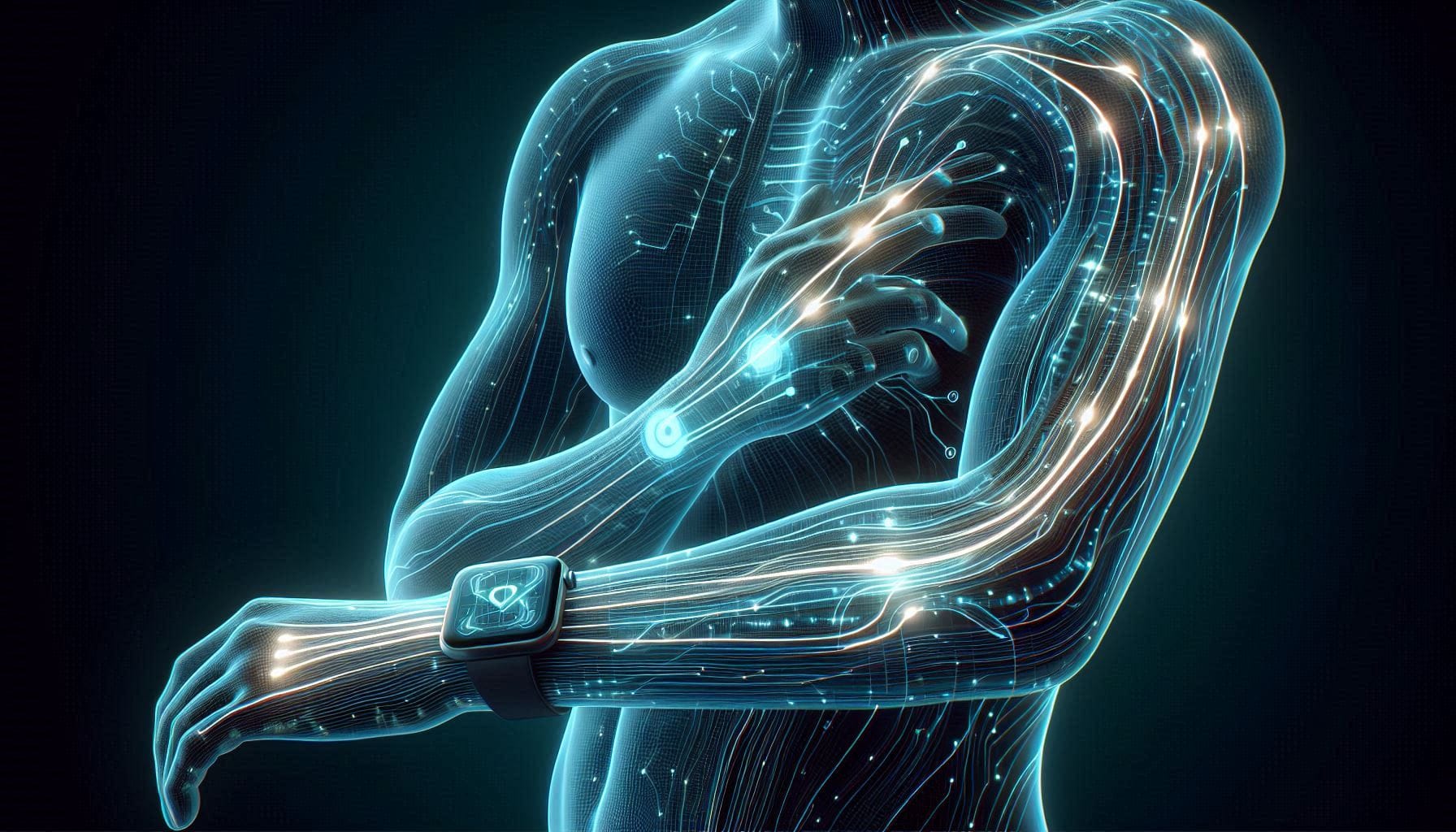Introduction: Reimagining the Human Body as a Power Source
In the rapidly evolving landscape of wearable technology, the quest for seamless integration and uninterrupted functionality has led to groundbreaking innovations. Among these, power-over-skin technology emerges as a transformative approach, leveraging the body’s natural properties to revolutionize how we power our devices.
Traditionally, wearable devices have relied on batteries, necessitating regular charging and contributing to electronic waste. However, the advent of wireless energy transfer methods that utilize human body conductivity offers a promising alternative. By transmitting energy through the skin, this technology enables battery-free wearables, enhancing user convenience and promoting sustainability.

Recent research from Carnegie Mellon University’s Future Interfaces Group has demonstrated the feasibility of this concept. Their studies show that the human body can efficiently transmit 40 MHz radio frequency (RF) energy along the skin, providing sufficient power to operate devices like microcontrollers capable of sensing and wireless communication.
This innovation not only paves the way for more compact and lightweight body-powered devices but also signifies a shift towards more integrated and user-friendly wearable technology. As we delve deeper into the mechanics and implications of power-over-skin technology, we uncover a future where our bodies themselves become conduits for energy, redefining our interaction with electronic devices.
What is Power-Over-Skin Technology?
Power-over-skin technology is an emerging field that explores the use of the human body’s conductive properties to facilitate wireless energy transfer to electronic devices worn on the skin. This method capitalizes on the body’s ability to conduct electrical signals, enabling energy to be transmitted from a source to various battery-free wearables distributed across the body.
The core principle involves the use of a single, battery-powered transmitter that sends low-frequency RF energy through the skin. This energy is then received by devices equipped with appropriate receivers, allowing them to function without the need for internal batteries. Such a system not only reduces the weight and size of wearable devices but also minimizes the environmental impact associated with battery disposal.
The efficacy of this technology hinges on the human body conductivity, which varies among individuals but remains within a range that supports effective energy transmission. Studies have shown that this method can power devices from head to toe, demonstrating the potential for full-body applications.
By eliminating the reliance on traditional power sources, power-over-skin technology offers a paradigm shift in the design and functionality of body-powered devices. It opens avenues for the development of more discreet, comfortable, and sustainable wearable technology, aligning with the growing demand for innovative solutions in personal electronics.
The Science Behind Wireless Energy Transfer Through Skin
As futuristic as it sounds, wireless energy transfer through the human body is firmly grounded in science. At the heart of this innovation lies the principle of human body conductivity—our natural ability to conduct low-frequency electrical signals across the skin and underlying tissues.
The Human Body as a Conductor
To understand how wireless energy transfer through skin is possible, it’s essential to explore how the body conducts electricity. While our skin may seem like a barrier, it actually possesses measurable skin impedance—the opposition it offers to the flow of electric current. The dermal and subdermal tissues, composed mostly of water and electrolytes, provide pathways that can support low-energy electrical conduction.
Key physical factors include:
- Skin impedance: Varies by location, hydration level, and individual physiology. It affects how much energy can flow through the skin without discomfort.
- Tissue conductivity: Muscles, fat, and blood have differing conductive properties, influencing how far and how efficiently signals can travel.
- Signal attenuation: As energy travels across the body, some of it is lost due to absorption and scattering by biological tissues. Optimizing the signal frequency minimizes this loss, ensuring sufficient power delivery to devices.
Coupling Methods: Capacitive and Resonant Inductive
Two primary methods facilitate this transmission:
- Capacitive Coupling
This method utilizes electric fields to induce current flow across the skin’s surface. Electrodes on the surface of the skin form a capacitive circuit with the transmitter, allowing small amounts of current to flow harmlessly through the outermost layers of the body. The setup resembles a distributed capacitor, with the body acting as the dielectric medium. - Resonant Inductive Coupling
Here, magnetic fields are used to transfer energy between a transmitting coil and receiving coil, both tuned to resonate at the same frequency. The human body plays a minimal role in this energy pathway but can act as a medium that carries the magnetic field, especially in wearable formats where devices are close together.
The breakthrough of power-over-skin technology comes from combining these two methods: using the human body as both a capacitive path and a medium for magnetic field transmission to extend energy transfer across limbs and even the entire body.
Safety and Biocompatibility
Naturally, the idea of sending electricity through the body raises questions of safety. But here’s why current research concludes it is non-invasive and safe:
- The system uses low-frequency RF signals—typically below 100 MHz—which are far below the levels known to cause thermal damage or interfere with biological processes.
- The energy levels involved are extremely low (typically in the milliwatt range), making them safe for continuous exposure.
- Materials used in wearable receivers are biocompatible, and energy is transmitted at levels that don’t cause heat or sensation.
Studies conducted by institutions like Carnegie Mellon University confirm that this approach meets all the established international safety guidelines for electromagnetic exposure. The technology essentially mimics the electric fields already present in everyday environments—just better harnessed and purposefully directed.
Real-World Applications: Battery-Free Wearables & Beyond
The promise of power-over-skin technology is most visible in its transformative impact on battery-free wearables—smart devices that draw power directly from the body, without the need for traditional batteries. This evolution is not just theoretical; it’s already reshaping the landscape of personal electronics, healthcare, and even textiles.
Smartwatches and Fitness Trackers
Today’s wearables often rely on daily or weekly charging routines, which disrupt usability and user experience. But body-powered devices using wireless energy transfer over the skin are changing that. Imagine smartwatches and fitness bands that are continuously powered as long as they’re worn, harvesting small amounts of electricity from your skin or nearby transmitter patches. This technology is already in experimental stages, with prototypes demonstrating real-time heart rate and step tracking without batteries.
Electronic Skin and Health Monitoring Patches
Another groundbreaking application lies in electronic skin (e-skin)—ultra-thin, flexible sensors that mimic human skin’s stretchability and sensitivity. These devices can track temperature, hydration, or bio-signals like ECG and EMG directly from the skin surface. Researchers at the University of Texas at Austin and Stanford University have pioneered skin-like, bioelectrical systems that not only collect physiological data but also draw energy wirelessly via power-over-skin systems.

The absence of batteries means these patches can be lighter, thinner, and more comfortable—ideal for long-term health monitoring, especially in elderly patients or infants.
Smart Textiles, Prosthetics, and Medical Implants
Looking forward, body-powered devices could become central to smart clothing—jackets or shirts that power embedded LEDs, biometric sensors, or even heating systems. In prosthetics, integrated circuits could be powered through the user’s skin conductivity, enabling features like temperature regulation or nerve interface enhancement. Medical implants—typically reliant on invasive battery replacements—stand to benefit immensely, with external skin contact pads transmitting power directly to internal devices.
The real promise lies in a seamless interface between the body and technology—a power system that feels natural and invisible while extending functionality beyond the limits of batteries.
Advantages Over Conventional Power Systems
The shift toward battery-free wearables isn’t just a technological upgrade—it’s a fundamental rethinking of how power is delivered to devices we wear, touch, and rely on daily. Power-over-skin technology offers several advantages over traditional battery-based systems:
Lightweight and Sustainable
Removing batteries from wearables means eliminating bulk and weight. This makes devices like smart patches, earbuds, and glasses significantly more comfortable and user-friendly—especially for children, athletes, and patients who require round-the-clock monitoring. It also reduces the need for power-hungry wireless charging setups.
Environmentally Friendly
One of the most compelling arguments for battery-free wearables is sustainability. Batteries not only require rare-earth metals and energy-intensive manufacturing, but they also create waste and pollution when improperly disposed of. By contrast, power-over-skin systems remove the need for disposable or replaceable power cells altogether, reducing e-waste and promoting circular product design.
Improved Design Freedom
Without the constraints of battery size, placement, and heat dissipation, designers have more freedom to create ergonomic, aesthetic, and versatile wearable products. This opens up opportunities for ultra-flexible, invisible electronics that integrate seamlessly with clothing, accessories, or even the skin itself. It’s a paradigm shift from clunky tech to truly body-integrated electronics.
Challenges and Limitations
While power-over-skin technology is redefining how wearables are powered, the path to widespread adoption isn’t without hurdles. The innovation is promising, but it faces critical technical, biological, and regulatory limitations that researchers and developers must address before it can scale reliably.
Energy Density Constraints
Perhaps the most immediate limitation of wireless energy transfer through the skin is its low energy output. Currently, the power generated or transferred is sufficient only for small-scale electronics such as temperature sensors, smart patches, or minimalist health monitors. It falls short when it comes to energy-intensive applications like smartphones, augmented reality glasses, or high-bandwidth communication tools. Until power-over-skin technology achieves higher energy density, its scope will remain limited to low-power, always-on devices.
Signal Interference and Skin Variability
Another layer of complexity lies in human biology. The conductivity of the human body varies between individuals depending on skin hydration, fat content, and environmental conditions like humidity. These variables influence how efficiently energy is transferred across the skin. Moreover, wireless energy transfer is vulnerable to electromagnetic interference from nearby electronics or structural materials like metals and reinforced concrete, which can reduce efficiency and stability.
Regulatory and Safety Challenges
Any technology that maintains continuous contact with human skin must adhere to strict regulatory and safety standards. Long-term exposure to energy fields, even at low intensities, raises questions about thermal effects, electromagnetic safety, and skin irritation. Governments and health agencies are still developing clear frameworks to assess and approve these devices. Until such standards are universally adopted, mass deployment in sensitive domains like healthcare or consumer tech will remain cautious and limited.
The Future of Body-Powered Devices
The future of body-powered devices stretches far beyond smartwatches and fitness trackers. With continuous innovation in materials science, bioelectronics, and micro-energy systems, we are entering an era where the human body becomes a functional energy node in smart environments.
Integration with Electronic Skin and Neural Interfaces
As electronic skin (e-skin) advances in realism and functionality, it is likely to become the central platform for body-powered devices. These ultra-thin, stretchable interfaces can be embedded with sensors, processors, and now energy systems that operate directly via human body conductivity. Future versions may include neural interfaces, allowing not just health tracking but also gesture-based control over IoT systems—turning the human body into both a controller and power source.
Hybrid Systems: Kinetic, Solar, and Skin-Based Power
Looking ahead, the most practical energy systems may be hybrid models, combining power-over-skin technology with kinetic energy harvesting and even ultra-thin solar patches. Imagine a wearable that charges from sunlight when you’re outdoors, movement when you’re exercising, and body conductivity when you’re stationary—all seamlessly orchestrated by an embedded energy management unit. These hybrid devices would eliminate downtime and extend functionality across use cases.
Speculative Vision: Power Exchange in Smart Cities
In future smart cities, we could see public infrastructure designed to wirelessly exchange energy with your wearable devices. Smart benches, bus stops, or building walls could boost your device’s charge via proximity—leveraging your body as a passive conductor while respecting privacy and safety. This would be a step toward a reciprocal energy ecosystem, where citizens are not just consumers but contributors to urban power flows.
Ethical and Social Implications
While power-over-skin technology offers exciting technical breakthroughs, it also opens up complex ethical and social conversations. As we develop wearable power solutions that use the body not only as a power source but potentially a communication channel, we must scrutinize the societal trade-offs.
Power and Data Convergence: A Consent Challenge
One major concern is the intertwining of power delivery and data exchange. If a device can receive energy via the body, could it also transmit personal data in the same flow? This dual-use channel raises significant data privacy concerns. For example, health trackers powered through power-over-skin technology might also collect biometric signals or user patterns. Without strict protocols on data encryption and user consent, there is a real risk of unauthorized surveillance or data breaches.
Accessibility and Inequality
Another critical question is: Who gets to use these technologies? Advanced wearable power solutions are likely to be costly in their early iterations, potentially making them accessible only to affluent users or high-tech regions. If not addressed, this could deepen existing technology gaps, leaving underprivileged communities without access to potentially life-saving tools like energy-harvesting health monitors or battery-free prosthetics.
Environmental Gains vs Surveillance Risks
On one hand, power-over-skin technology could significantly reduce e-waste by eliminating disposable batteries, promoting environmental sustainability. But on the other, widespread adoption of body-integrated devices raises surveillance risks—especially if used without sufficient legal frameworks. Governments, companies, and developers must collaborate to balance innovation with public trust, ensuring that personal freedom and data sovereignty are not compromised in the pursuit of smarter tech.
Conclusion: A Body That Powers Itself
The human body has long been viewed as a vessel for biological function. But today, it’s evolving into something far more dynamic: a renewable power source for the next generation of electronics. Through the lens of power-over-skin technology, we’re witnessing the transformation of skin into a living circuit board—one capable of energizing wearables, health monitors, and IoT systems.
Body-powered devices are no longer science fiction. From fitness trackers charged by skin contact to medical implants running on your body’s natural conductivity, we are entering an era where battery-free living is not only possible but increasingly practical.
The road ahead will require thoughtful design, equitable access, and ethical oversight. Yet the potential is undeniable. In a world yearning for greener, smarter technology, the body itself may hold the key.
So we end with a question:
Could your body be the next power plant for the Internet of Things?
🔋 Explore More Breakthroughs in Human-Centric Energy Tech
If Power-Over-Skin Technology sparked your curiosity, you’ll love diving into these fascinating innovations:
-
🧍♂️ Body Energy Harvesting – Discover how your own movement and heat can power the world around you.
-
🖋️ Smart Tattoo Sensors – Explore next-gen skin electronics that monitor health and power devices seamlessly.
-
🧵 Piezoelectric Fabrics and Wearable Energy Harvesting – Learn how smart textiles turn motion into usable electricity.
-
🌬️ Ambient Energy Harvesting – See how we’re tapping into invisible forces like light, sound, and vibrations.
-
🚗 Energy Harvesting with Piezoelectric Roads – Uncover how highways are being reimagined as clean energy generators.
🧠 Stay ahead of the curve—these technologies are shaping the future of sustainable, body-powered innovation.






